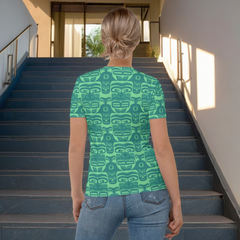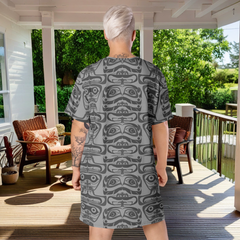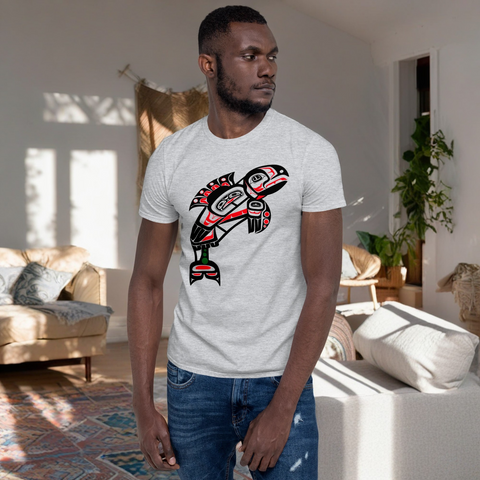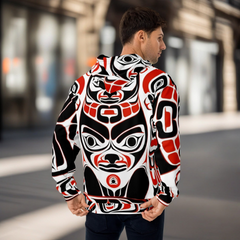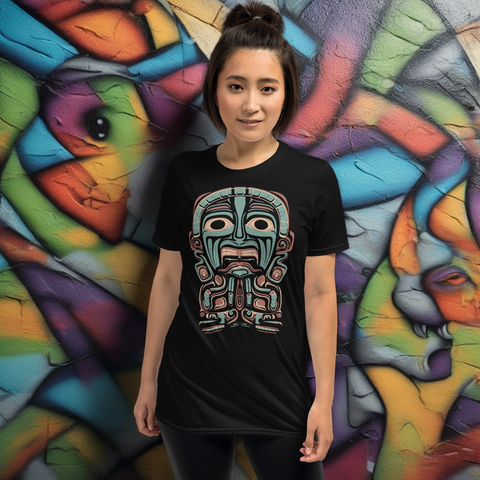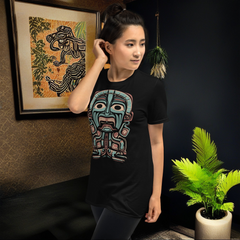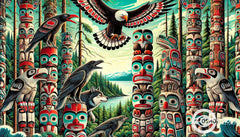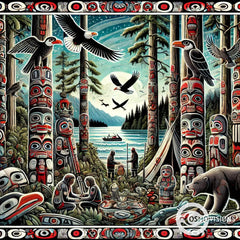Haida Gwaii Nation: Council Of The Haida Nation
Posted by Massimiliano Geraci

Are you captivated by the rich tapestry of indigenous cultures and their histories? Maybe you’ve heard of Haida Gwaii but know little about its people and governance. You’re in for a fascinating journey through time, culture, and leadership. The British Columbia government played a significant role in renaming the Queen Charlotte Islands to Haida Gwaii, marking a historic moment of recognition and respect for the Haida Nation.
Did you know the Haida have inhabited these islands for at least 12,500 years? Their resilience is evident in their longevity and how they’ve maintained their cultural heritage despite numerous challenges.
In this blog post, we’ll explore the history of the Haida Nation, focusing on the Council of the Haida Nation (CHN). We’ll delve into their key achievements, efforts to preserve culture, and ongoing struggles.
This glimpse into their world promises to be both educational and inspiring. Keep reading!
Key Takeaways
The Haida have lived on the islands of Haida Gwaii for at least 12,500 years. Despite facing numerous challenges, such as smallpox epidemics and cultural oppression, their culture remains vibrant today.
The Council of the Haida Nation (CHN), formed in 1974, governs all Haida territories and plays a crucial role in protecting their land and cultural heritage. Their actions include overseeing potlatches and fighting against outside threats.
Key achievements by the CHN include successful protests against logging that led to the establishment of Gwaii Haanas National Park in 1987, renaming the archipelago to Haida Gwaii in 2009, and repatriating over 500 ancestral remains.
Notably, SGang Gwaay, part of the Haida Heritage Sites within Gwaii Haanas, has been designated as a UNESCO World Heritage Site, recognized for its well-preserved Pacific Northwest mortuary poles that offer a glimpse into the historical Haida culture and its spiritual significance.
Efforts to preserve culture involve initiatives like language revitalization programs started in the 1970s and the creation of cultural centers such as the Haida Heritage Centre. Films entirely in the Haida language further these goals.
CHN’s challenges include repatriating scattered cultural treasures from global museums and addressing the impacts of historical events like residential schools, which stripped many children of their native language and customs.
Historical Background of Haida Gwaii Nation, Formerly Known as Queen Charlotte Islands
Transitioning from the introduction, the Haida Gwaii Nation boasts a rich history. The Haida people have lived on this archipelago in British Columbia for at least 12,500 years. Ancient lodgepole pines first appeared 14,000 to 19,000 years ago.
Spanish explorer Juan Pérez became the first European to contact them in July 1774.
A devastating smallpox epidemic hit in 1862, reducing the population from around 6,607 to 829 by 1881. That same year, police forced back twenty canoes full of Haidas with support from gunboats HMS Grappler and HMS Forward.
Despite these challenges, the Haida culture remains vibrant today… thriving through its art and traditions. Our mountains are our pillars; our rivers are our veins.
The geological movement of the Haida Gwaii islands from the South Pacific underscores the region's dynamic history, further enriching its unique biological and cultural features.

Formation and Role of the Council of the Haida Nation
The Council of the Haida Nation (CHN) formed in 1974 to unite and govern the Haida people. This council governs all Haida territories, including Old Massett and Skidegate, and plays a crucial role in the governance of Daajing Giids (formerly Queen Charlotte), highlighting its significance in the context of the Council of the Haida Nation's governance and the history of the area. It includes members from village councils, hereditary chiefs, and elected representatives.
The CHN plays a key role in protecting Haida culture and land. They fight for their rights against outside threats. The council also oversees cultural activities like potlatches, which were once banned.
Through this leadership, the CHN aims to preserve the rich heritage of their ancestors while adapting to modern challenges.
Key Achievements and Initiatives by the Council
The Council of the Haida Nation has achieved many significant milestones. These efforts have greatly impacted both their people and land.
1. Protest Against Logging (1985): Haida protested against logging on Lyell Island. This led to the establishment of Gwaii Haanas National Park in 1987.
2. Renaming of the Archipelago (2009): The archipelago’s name was changed from Queen Charlotte Islands to Haida Gwaii. This marked a step towards reclaiming their heritage.
3. End of Mourning Ceremony (2005): The Haida Repatriation Committee held this ceremony, signifying the return of ancestral remains.
4. Successful Repatriation Efforts: Over 500 human remains were returned to their homeland from museums worldwide, healing old wounds within the community.
5. Creation of Cultural Centers: Established facilities like the Haida Heritage Centre to preserve and share Haida culture with others.
6. Protection of Land: Nearly 70% of Haida Gwaii’s one million hectares is now protected land, including significant areas on Graham Island and within Naikoon Provincial Park, ensuring environmental conservation and the protection of landmarks such as the Kiidk'yaas tree and habitats for unique species like the Haida ermine.
7. Promotion of Haida Art: Celebrated artists like Bill Reid have gained international recognition, highlighting traditional and contemporary Haida art forms.
8. Language Revitalization Programs: Initiatives have been launched to revive and teach the Haida language within schools and communities.
Next topic…

Cultural Preservation and Repatriation Efforts
Haida Gwaii Nation has worked tirelessly to bring back their ancestors. From 1991 to 2016, over 500 remains were repatriated, and these precious pieces of history are held in museums around the world.
Haida also reclaimed artifacts and spiritual objects, many made from red cedar. This effort strengthens their connection to the past.
Language revitalization projects began in the 1970s. These programs taught children and adults to speak Haida again. In 2018, a milestone was reached with the release of The Edge of the Knife, a film entirely in Haida language.
This movie captures traditional stories and showcases cultural pride. Our ancestors are coming home. Global awareness continues to grow about this vital work by Old Massett Village Council and other Haida groups. The deep connection of the Haida Gwaii Nation to the Pacific Ocean is a testament to their rich cultural and environmental heritage, reflecting their unique relationship with the natural world.
Supplementary Information on Haida Gwaii Nation and the Hecate Strait
The Haida are renowned for their intricate art and potlatch traditions, which hold deep cultural significance. Prominent figures from the Haida community, such as Robert Davidson and Gwaai Edenshaw, continue to shape and celebrate Haida heritage through their work. Vancouver Island, lying beyond Queen Charlotte Sound and close to Haida Gwaii, shares a historical connection through migration routes and European contact, further enriching the region's cultural tapestry.
Prominent Haida Figures
Lisa Telford is a master weaver known for her intricate cedar bark creations. She learned the craft from her grandmother and continues to share traditional Haida weaving techniques with younger generations.
Delores Churchill, another exceptional artisan, specializes in basketry and is celebrated for preserving this vital aspect of Haida culture.
Robert Davidson is a renowned Haida artist who has significantly contributed to contemporary art and cultural preservation. His works include stunning totem poles and prints that blend old traditions with modern styles.
Chief 7iDANsuu James Hart carved the Reconciliation Pole in 2017, embedding over 50,000 copper nails to honor those affected by residential schools.

Haida Art, Potlatch Traditions, and Cultural Insights
Haida art forms tell stories. Totem poles stand tall and proud, showing the bond between the Haida people and their ancestors. Chilkat weaving creates intricate patterns using natural materials like cedar bark and mountain goat wool.
Jewelry crafted by Haida artists sparkles with meaning—each piece a miniature world of its own.
The potlatch has deep cultural significance. Held to honor important events, it strengthens bonds within Haida society. In 1885, the Potlatch Ban attempted to erase this tradition, but it did not succeed in silencing the spirit of the Haida people.
By 2017, a splendid two-day potlatch revived old customs under Chief Gidansda’s Moon and Mountain Goat Chest....
Challenges Faced by the Council
The Council of the Haida Nation faces many challenges. One issue is cultural preservation. Much of their heritage, including over 12,000 Haida cultural treasures, is scattered in museums worldwide.
These artifacts are crucial for teaching younger generations about their roots and traditions. The council seeks to repatriate these items back to Haida Gwaii but encounters resistance from institutions that hold them.
Another challenge is the impact of historical events on Haida society. Between 1911 and 1978, many Haida children were sent to residential schools where they were stripped of their language and customs.
This led to losing important cultural knowledge and practices among new generations. Additionally, the smallpox epidemic 1862 drastically reduced the population from about 6,607 to 829 people by 1881, further fragmenting communities and weakening social bonds essential for maintaining traditions and governance systems effectively today.
The Hecate Strait plays a significant role in the isolation of Haida Gwaii, presenting challenges for cultural preservation due to its treacherous waters that separate the islands from the mainland, making access difficult but also contributing to the region's unique ecosystem.
Conclusion
The Haida Gwaii Nation has a rich history that spans thousands of years. The Council of the Haida Nation works hard to protect their land and culture. They lead efforts in preserving traditions and caring for the environment.
Their achievements inspire pride among the people of Haida ancestry. Facing many challenges, they remain resilient and strong.
FAQs
1. What is the Haida Gwaii Nation?
The Haida Gwaii Nation, also known as the people of Haida ancestry, lives on islands off the coast of British Columbia.
2. Who are the Council of the Haida Nation?
The Council of the Haida Nation represents and governs the indigenous people living in this region.
3. What is unique about Haida social organization?
Haida social organization includes clans that trace their lineage through mothers, with strong ties to family and community.
4. Where can you find traditional Haida villages?
Traditional Haida villages can be found on Moresby Island and Prince of Wales Island.
5. How did warriors from the tribe protect themselves?
Warriors used armor made from wood and animal hides for protection during battles.
6. Are there any famous figures or storytellers among them?
Yes, classical mythtellers like Helen Haig-Brown share rich tales about supernatural beings and historical events




